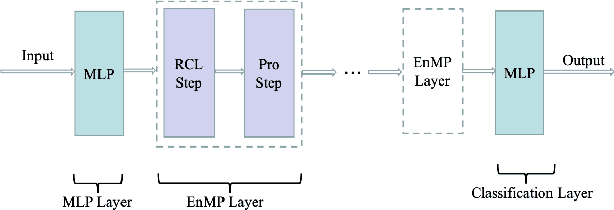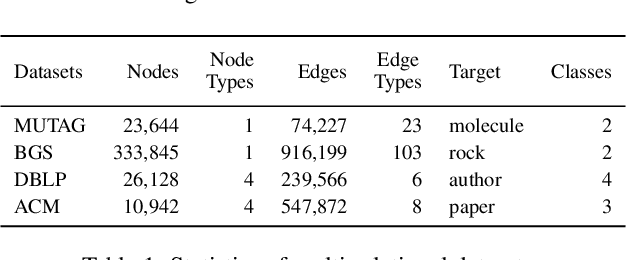Yanhua Yu
LightPROF: A Lightweight Reasoning Framework for Large Language Model on Knowledge Graph
Apr 04, 2025Abstract:Large Language Models (LLMs) have impressive capabilities in text understanding and zero-shot reasoning. However, delays in knowledge updates may cause them to reason incorrectly or produce harmful results. Knowledge Graphs (KGs) provide rich and reliable contextual information for the reasoning process of LLMs by structurally organizing and connecting a wide range of entities and relations. Existing KG-based LLM reasoning methods only inject KGs' knowledge into prompts in a textual form, ignoring its structural information. Moreover, they mostly rely on close-source models or open-source models with large parameters, which poses challenges to high resource consumption. To address this, we propose a novel Lightweight and efficient Prompt learning-ReasOning Framework for KGQA (LightPROF), which leverages the full potential of LLMs to tackle complex reasoning tasks in a parameter-efficient manner. Specifically, LightPROF follows a "Retrieve-Embed-Reason process", first accurately, and stably retrieving the corresponding reasoning graph from the KG through retrieval module. Next, through a Transformer-based Knowledge Adapter, it finely extracts and integrates factual and structural information from the KG, then maps this information to the LLM's token embedding space, creating an LLM-friendly prompt to be used by the LLM for the final reasoning. Additionally, LightPROF only requires training Knowledge Adapter and can be compatible with any open-source LLM. Extensive experiments on two public KGQA benchmarks demonstrate that LightPROF achieves superior performance with small-scale LLMs. Furthermore, LightPROF shows significant advantages in terms of input token count and reasoning time.
Addressing Heterogeneity and Heterophily in Graphs: A Heterogeneous Heterophilic Spectral Graph Neural Network
Oct 17, 2024Abstract:Graph Neural Networks (GNNs) have garnered significant scholarly attention for their powerful capabilities in modeling graph structures. Despite this, two primary challenges persist: heterogeneity and heterophily. Existing studies often address heterogeneous and heterophilic graphs separately, leaving a research gap in the understanding of heterogeneous heterophilic graphs-those that feature diverse node or relation types with dissimilar connected nodes. To address this gap, we investigate the application of spectral graph filters within heterogeneous graphs. Specifically, we propose a Heterogeneous Heterophilic Spectral Graph Neural Network (H2SGNN), which employs a dual-module approach: local independent filtering and global hybrid filtering. The local independent filtering module applies polynomial filters to each subgraph independently to adapt to different homophily, while the global hybrid filtering module captures interactions across different subgraphs. Extensive empirical evaluations on four real-world datasets demonstrate the superiority of H2SGNN compared to state-of-the-art methods.
LightRAG: Simple and Fast Retrieval-Augmented Generation
Oct 08, 2024



Abstract:Retrieval-Augmented Generation (RAG) systems enhance large language models (LLMs) by integrating external knowledge sources, enabling more accurate and contextually relevant responses tailored to user needs. However, existing RAG systems have significant limitations, including reliance on flat data representations and inadequate contextual awareness, which can lead to fragmented answers that fail to capture complex inter-dependencies. To address these challenges, we propose LightRAG, which incorporates graph structures into text indexing and retrieval processes. This innovative framework employs a dual-level retrieval system that enhances comprehensive information retrieval from both low-level and high-level knowledge discovery. Additionally, the integration of graph structures with vector representations facilitates efficient retrieval of related entities and their relationships, significantly improving response times while maintaining contextual relevance. This capability is further enhanced by an incremental update algorithm that ensures the timely integration of new data, allowing the system to remain effective and responsive in rapidly changing data environments. Extensive experimental validation demonstrates considerable improvements in retrieval accuracy and efficiency compared to existing approaches. We have made our LightRAG open-source and available at the link: https://github.com/HKUDS/LightRAG.
Can Small Language Models be Good Reasoners for Sequential Recommendation?
Mar 07, 2024



Abstract:Large language models (LLMs) open up new horizons for sequential recommendations, owing to their remarkable language comprehension and generation capabilities. However, there are still numerous challenges that should be addressed to successfully implement sequential recommendations empowered by LLMs. Firstly, user behavior patterns are often complex, and relying solely on one-step reasoning from LLMs may lead to incorrect or task-irrelevant responses. Secondly, the prohibitively resource requirements of LLM (e.g., ChatGPT-175B) are overwhelmingly high and impractical for real sequential recommender systems. In this paper, we propose a novel Step-by-step knowLedge dIstillation fraMework for recommendation (SLIM), paving a promising path for sequential recommenders to enjoy the exceptional reasoning capabilities of LLMs in a "slim" (i.e., resource-efficient) manner. We introduce CoT prompting based on user behavior sequences for the larger teacher model. The rationales generated by the teacher model are then utilized as labels to distill the downstream smaller student model (e.g., LLaMA2-7B). In this way, the student model acquires the step-by-step reasoning capabilities in recommendation tasks. We encode the generated rationales from the student model into a dense vector, which empowers recommendation in both ID-based and ID-agnostic scenarios. Extensive experiments demonstrate the effectiveness of SLIM over state-of-the-art baselines, and further analysis showcasing its ability to generate meaningful recommendation reasoning at affordable costs.
Intent-aware Recommendation via Disentangled Graph Contrastive Learning
Mar 06, 2024



Abstract:Graph neural network (GNN) based recommender systems have become one of the mainstream trends due to the powerful learning ability from user behavior data. Understanding the user intents from behavior data is the key to recommender systems, which poses two basic requirements for GNN-based recommender systems. One is how to learn complex and diverse intents especially when the user behavior is usually inadequate in reality. The other is different behaviors have different intent distributions, so how to establish their relations for a more explainable recommender system. In this paper, we present the Intent-aware Recommendation via Disentangled Graph Contrastive Learning (IDCL), which simultaneously learns interpretable intents and behavior distributions over those intents. Specifically, we first model the user behavior data as a user-item-concept graph, and design a GNN based behavior disentangling module to learn the different intents. Then we propose the intent-wise contrastive learning to enhance the intent disentangling and meanwhile infer the behavior distributions. Finally, the coding rate reduction regularization is introduced to make the behaviors of different intents orthogonal. Extensive experiments demonstrate the effectiveness of IDCL in terms of substantial improvement and the interpretability.
* Accepted by IJCAI 2023
GraphEdit: Large Language Models for Graph Structure Learning
Mar 05, 2024Abstract:Graph Structure Learning (GSL) focuses on capturing intrinsic dependencies and interactions among nodes in graph-structured data by generating novel graph structures. Graph Neural Networks (GNNs) have emerged as promising GSL solutions, utilizing recursive message passing to encode node-wise inter-dependencies. However, many existing GSL methods heavily depend on explicit graph structural information as supervision signals, leaving them susceptible to challenges such as data noise and sparsity. In this work, we propose GraphEdit, an approach that leverages large language models (LLMs) to learn complex node relationships in graph-structured data. By enhancing the reasoning capabilities of LLMs through instruction-tuning over graph structures, we aim to overcome the limitations associated with explicit graph structural information and enhance the reliability of graph structure learning. Our approach not only effectively denoises noisy connections but also identifies node-wise dependencies from a global perspective, providing a comprehensive understanding of the graph structure. We conduct extensive experiments on multiple benchmark datasets to demonstrate the effectiveness and robustness of GraphEdit across various settings. We have made our model implementation available at: https://github.com/HKUDS/GraphEdit.
Improving Expressive Power of Spectral Graph Neural Networks with Eigenvalue Correction
Jan 28, 2024Abstract:In recent years, spectral graph neural networks, characterized by polynomial filters, have garnered increasing attention and have achieved remarkable performance in tasks such as node classification. These models typically assume that eigenvalues for the normalized Laplacian matrix are distinct from each other, thus expecting a polynomial filter to have a high fitting ability. However, this paper empirically observes that normalized Laplacian matrices frequently possess repeated eigenvalues. Moreover, we theoretically establish that the number of distinguishable eigenvalues plays a pivotal role in determining the expressive power of spectral graph neural networks. In light of this observation, we propose an eigenvalue correction strategy that can free polynomial filters from the constraints of repeated eigenvalue inputs. Concretely, the proposed eigenvalue correction strategy enhances the uniform distribution of eigenvalues, thus mitigating repeated eigenvalues, and improving the fitting capacity and expressive power of polynomial filters. Extensive experimental results on both synthetic and real-world datasets demonstrate the superiority of our method.
Omni-Line-of-Sight Imaging for Holistic Shape Reconstruction
Apr 21, 2023



Abstract:We introduce Omni-LOS, a neural computational imaging method for conducting holistic shape reconstruction (HSR) of complex objects utilizing a Single-Photon Avalanche Diode (SPAD)-based time-of-flight sensor. As illustrated in Fig. 1, our method enables new capabilities to reconstruct near-$360^\circ$ surrounding geometry of an object from a single scan spot. In such a scenario, traditional line-of-sight (LOS) imaging methods only see the front part of the object and typically fail to recover the occluded back regions. Inspired by recent advances of non-line-of-sight (NLOS) imaging techniques which have demonstrated great power to reconstruct occluded objects, Omni-LOS marries LOS and NLOS together, leveraging their complementary advantages to jointly recover the holistic shape of the object from a single scan position. The core of our method is to put the object nearby diffuse walls and augment the LOS scan in the front view with the NLOS scans from the surrounding walls, which serve as virtual ``mirrors'' to trap lights toward the object. Instead of separately recovering the LOS and NLOS signals, we adopt an implicit neural network to represent the object, analogous to NeRF and NeTF. While transients are measured along straight rays in LOS but over the spherical wavefronts in NLOS, we derive differentiable ray propagation models to simultaneously model both types of transient measurements so that the NLOS reconstruction also takes into account the direct LOS measurements and vice versa. We further develop a proof-of-concept Omni-LOS hardware prototype for real-world validation. Comprehensive experiments on various wall settings demonstrate that Omni-LOS successfully resolves shape ambiguities caused by occlusions, achieves high-fidelity 3D scan quality, and manages to recover objects of various scales and complexity.
Ensemble Multi-Relational Graph Neural Networks
May 24, 2022



Abstract:It is well established that graph neural networks (GNNs) can be interpreted and designed from the perspective of optimization objective. With this clear optimization objective, the deduced GNNs architecture has sound theoretical foundation, which is able to flexibly remedy the weakness of GNNs. However, this optimization objective is only proved for GNNs with single-relational graph. Can we infer a new type of GNNs for multi-relational graphs by extending this optimization objective, so as to simultaneously solve the issues in previous multi-relational GNNs, e.g., over-parameterization? In this paper, we propose a novel ensemble multi-relational GNNs by designing an ensemble multi-relational (EMR) optimization objective. This EMR optimization objective is able to derive an iterative updating rule, which can be formalized as an ensemble message passing (EnMP) layer with multi-relations. We further analyze the nice properties of EnMP layer, e.g., the relationship with multi-relational personalized PageRank. Finally, a new multi-relational GNNs which well alleviate the over-smoothing and over-parameterization issues are proposed. Extensive experiments conducted on four benchmark datasets well demonstrate the effectiveness of the proposed model.
 Add to Chrome
Add to Chrome Add to Firefox
Add to Firefox Add to Edge
Add to Edge